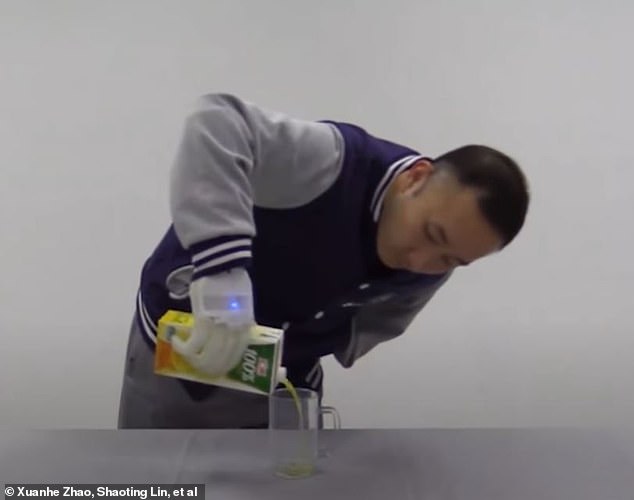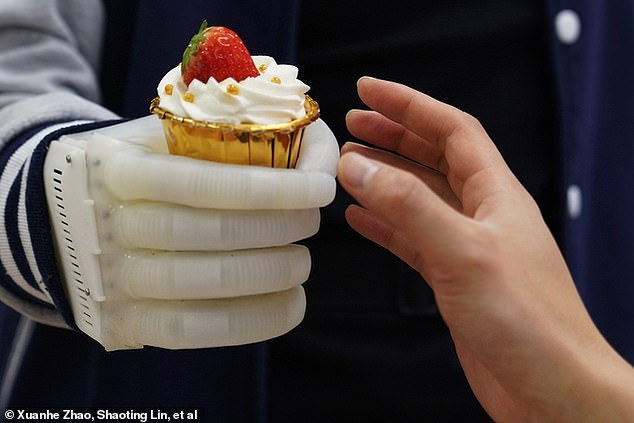Scientists have created an inflatable robotic hand that costs a fraction of more rigid prosthetic limbs and gives amputees real-time tactile control.
The pliable design, which bears an uncanny resemblance to the inflatable robot in the animated film ‘Big Hero 6’, includes five balloon-like fingers attached to a 3D-printed ‘palm’ shaped like a human hand.
Its creators are particularly excited because the parts cost around $500 (£362), making it much more affordable than other bionic limbs that can cost tens of thousands of dollars.

Low-cost: Scientists have created an inflatable robotic hand that costs a fraction of more rigid prosthetic limbs and gives amputees real-time tactile control (pictured)

The pliable design includes five balloon-like fingers attached to a 3D-printed ‘palm’ shaped like a human hand
How do mind-controlled prosthetics work?
Prosthetics that attach to part of the human body are often objects that allow a person to perform a specific function – such as blades for running.
Scientists are working to develop prosthetics that are personalised and respond to the commands of the wearer.
To do this, small pads are placed on the skin of the patient.
They are located around the end of muscles and where the nerve endings begin.
The pads detect the electrical signals that are produced by the muscle nerves and translate this via a computer.
To trigger these sensors, the patient must actively think about performing an action.
For example, in order to signal a bicep contraction, the person wearing the prosthetic would have to think about bending their arm.
By understanding what muscles are being signalled by the brain to contract, scientists can predict how a limb would move.
This is then recreated by the prosthetic in real-time, allowing wearers to think an action and then the artificial limb will perform it.
Advertisement
Amputees who tested the artificial limb performed daily activities, such as zipping a suitcase, pouring a carton of juice, and petting a cat, just as well as — and in some cases better than — those with more rigid neuroprosthetics, researchers said.
The smart hand, which weighs about half a pound, was designed by engineers at Massachusetts Institute of Technology (MIT) and Shanghai Jiao Tong University.
They found that the prosthetic, designed with a system for tactile feedback, restored some primitive sensation in a volunteer’s residual limb.
It is also surprisingly durable, quickly recovering after being struck with a hammer or run over with a car, the scientists said.
‘This is not a product yet, but the performance is already similar or superior to existing neuroprosthetics, which we’re excited about,’ said Xuanhe Zhao, professor of mechanical engineering and of civil and environmental engineering at MIT.
‘There’s huge potential to make this soft prosthetic very low cost, for low-income families who have suffered from amputation.’
The drawbacks to similar neuroprosthetic hands are their weight, with many over 400g, price — some cost more than $10,000 — and their lack of tactile feedback.
Rather than controlling each finger using mounted electrical motors, as most neuroprosthetics do, the MIT researchers used a simple pneumatic system to precisely inflate fingers and bend them in specific positions.
This system, including a small pump and valves, can be worn at the waist, significantly reducing the prosthetic’s weight.
Engineers developed a computer model to relate a finger’s desired position to the corresponding pressure a pump would have to apply to achieve that position.
Using this model, the team created a controller that directs the pneumatic system to inflate the fingers, in positions that mimic five common grasps, including pinching two and three fingers together, making a balled-up fist, and cupping the palm.
The pneumatic system receives signals from EMG sensors — electromyography sensors that measure electrical signals generated by motor neurons to control muscles.
The sensors are fitted at the prosthetic’s opening, where it attaches to a user’s limb. This allows them to pick up signals from a residual limb, such as when an amputee imagines making a fist.
The team then used an existing algorithm that ‘decodes’ muscle signals and relates them to common grasp types.

It bears an uncanny resemblance to the inflatable robot in the animated film ‘Big Hero 6’

The prosthetic’s creators are excited because the parts cost around $500 (£362), making it much more affordable than other bionic limbs that can cost tens of thousands of dollars

Amputees who tested the artificial limb performed daily activities, such as zipping a suitcase, pouring a carton of juice, and petting a cat
They used this algorithm to program the controller for their pneumatic system.
When an amputee imagines, for instance, holding a wine glass, the sensors pick up the residual muscle signals, which the controller then translates into corresponding pressures.
The pump then applies those pressures to inflate each finger and produce the amputee’s intended grasp.
Going a step further in their design, the researchers looked to enable tactile feedback — a feature that is not incorporated in most commercial neuroprosthetics.
To do this, they stitched to each fingertip a pressure sensor, which when touched or squeezed produces an electrical signal proportional to the sensed pressure.
Each sensor is wired to a specific location on an amputee’s residual limb, so the user can ‘feel’ when the prosthetic’s thumb is pressed, for example, versus the forefinger.
To test the inflatable hand, the researchers enlisted two volunteers, each with upper-limb amputations.
Once fitted with the neuroprosthetic, the volunteers learned to use it by repeatedly contracting the muscles in their arm while imagining making five common grasps.
After completing this 15-minute training, the volunteers were asked to perform a number of tests to demonstrate manual strength and dexterity.
These included stacking checkers, turning pages, writing with a pen, lifting heavy balls, and picking up fragile objects like strawberries and bread.
They repeated the same tests using a more rigid, commercially available bionic hand and found that the inflatable prosthetic was as good, or even better, at most tasks, compared to its rigid counterpart.

The smart hand, which weighs about half a pound, was designed by engineers at Massachusetts Institute of Technology (MIT) and Shanghai Jiao Tong University

Rather than controlling each finger with mounted electrical motors, as most neuroprosthetics do, the researchers used a simple pneumatic system to precisely inflate fingers and bend them
One volunteer was also able to intuitively use the soft prosthetic in daily activities, for instance to eat food such as crackers, cake, and apples, and to handle objects and tools, such as laptops, bottles, hammers and pliers.
He could also shake someone’s hand, touch a flower, and pet a cat.
Researchers then blindfolded the volunteer and found he could tell which prosthetic finger they poked and brushed.
He was also able to ‘feel’ bottles of different sizes that were placed in the prosthetic hand, and lifted them in response.
Scientist believe these experiments are a promising sign that amputees can regain a form of sensation and real-time control with the inflatable hand.
The team has filed a patent on the design, through MIT, and is working to improve its sensing and range of motion.
‘We now have four grasp types. There can be more,’ Zhao says. ‘This design can be improved, with better decoding technology, higher-density myoelectric arrays, and a more compact pump that could be worn on the wrist.
‘We also want to customise the design for mass production, so we can translate soft robotic technology to benefit society.’
The robotic hand research is published in the journal Nature Biomedical Engineering.
Implants that allow bionic arms to be operated by THOUGHT alone will be available in Europe within two years 
Three people in Sweden use an implant system that allows amputees to use a bionic arm with just their thoughts. Dr Max Ortiz Cataln at Chalmers University of Technology hopes the technology can be expanded to Europe. The implant system anchors the prosthesis to the skeleton in the stump of the amputated limb
Amputees could be able to use bionic arms with nothing but their thoughts within the next two years, Swedish researchers have said.
An implant system that allows the use of a bionic arm without the need for any supporting equipment is already available in Sweden.
Now the team behind it are working toward getting European certification to help more people.
Three Swedes who have had an amputation use the technology, which can connect to any arm prosthesis that is commercially available.
Dr Max Ortiz Catalan, an associate professor at Chalmers University of Technology in Sweden, said that their prosthesis could be a clinically viable replacement for a lost arm.
He told the PA news agency: ‘People in Sweden can have this technology now.
‘We were working to ramp up the production before the pandemic began.
‘We are aiming to have it CE marked soon, within two years, and once it is CE marked, it can be available in Europe as a product.’
Two of the three patients involved in their clinical trial have been using their bionic arms for around three years, while the third participant has been using his artificial limb for seven years.
A new functionality – the sensation of touch – has recently been added to all the three prosthetic arms.
Dr Ortiz Catalan said that the implant system, which anchors the prosthesis to the skeleton in the stump of the amputated limb, is stable and can be used for long periods of time without any intervention from the scientists.
He said: ‘The real breakthrough here is that this neuromusculoskeletal interface, as we call it, allows the artificial limb to be connected to the body.
‘And when you have that intimate connection between the technology and biology, you can have a better control and establish sensory feedback.’
Advertisement
Source link : https://www.dailymail.co.uk/sciencetech/article-9900909/Inflatable-robotic-hand-gives-amputees-real-time-tactile-control.html











